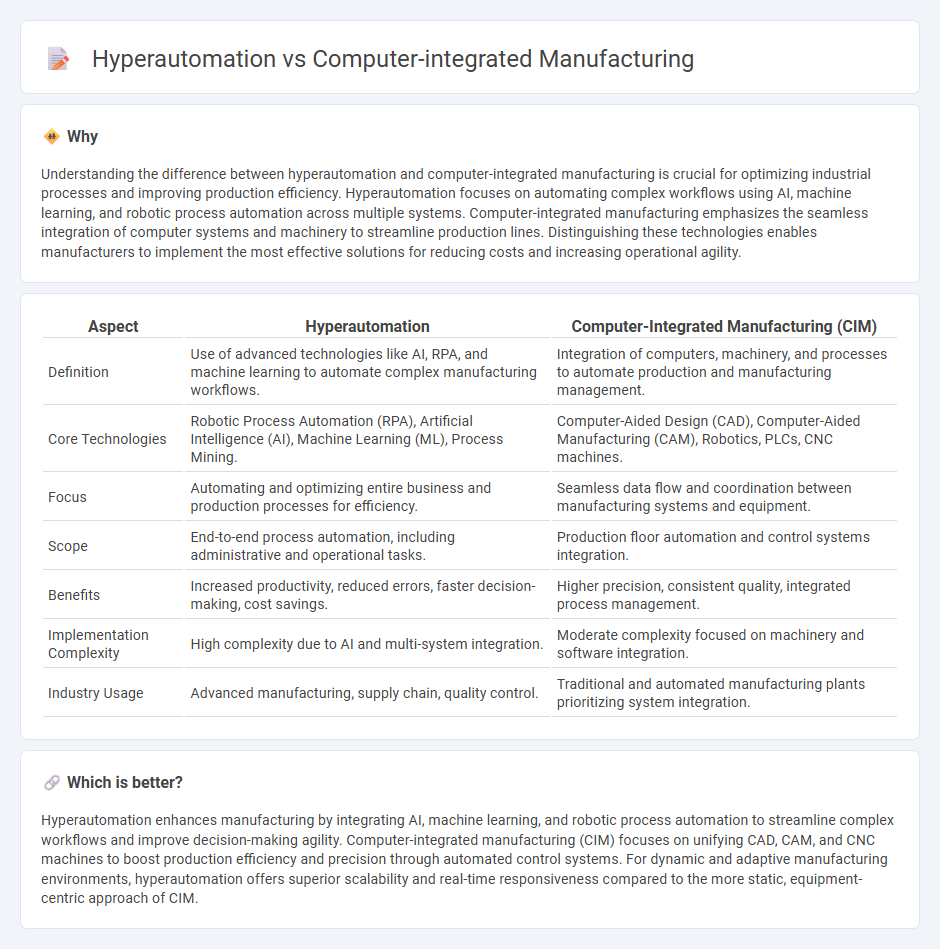
Hyperautomation leverages advanced technologies such as artificial intelligence, machine learning, and robotic process automation to streamline and optimize manufacturing workflows with minimal human intervention. Computer-integrated manufacturing (CIM) integrates computer systems, machinery, and software to coordinate manufacturing processes for increased efficiency and precision. Explore the differences and benefits of hyperautomation and CIM to enhance your manufacturing strategy.
Why it is important
Understanding the difference between hyperautomation and computer-integrated manufacturing is crucial for optimizing industrial processes and improving production efficiency. Hyperautomation focuses on automating complex workflows using AI, machine learning, and robotic process automation across multiple systems. Computer-integrated manufacturing emphasizes the seamless integration of computer systems and machinery to streamline production lines. Distinguishing these technologies enables manufacturers to implement the most effective solutions for reducing costs and increasing operational agility.
Comparison Table
| Aspect | Hyperautomation | Computer-Integrated Manufacturing (CIM) |
|---|---|---|
| Definition | Use of advanced technologies like AI, RPA, and machine learning to automate complex manufacturing workflows. | Integration of computers, machinery, and processes to automate production and manufacturing management. |
| Core Technologies | Robotic Process Automation (RPA), Artificial Intelligence (AI), Machine Learning (ML), Process Mining. | Computer-Aided Design (CAD), Computer-Aided Manufacturing (CAM), Robotics, PLCs, CNC machines. |
| Focus | Automating and optimizing entire business and production processes for efficiency. | Seamless data flow and coordination between manufacturing systems and equipment. |
| Scope | End-to-end process automation, including administrative and operational tasks. | Production floor automation and control systems integration. |
| Benefits | Increased productivity, reduced errors, faster decision-making, cost savings. | Higher precision, consistent quality, integrated process management. |
| Implementation Complexity | High complexity due to AI and multi-system integration. | Moderate complexity focused on machinery and software integration. |
| Industry Usage | Advanced manufacturing, supply chain, quality control. | Traditional and automated manufacturing plants prioritizing system integration. |
Which is better?
Hyperautomation enhances manufacturing by integrating AI, machine learning, and robotic process automation to streamline complex workflows and improve decision-making agility. Computer-integrated manufacturing (CIM) focuses on unifying CAD, CAM, and CNC machines to boost production efficiency and precision through automated control systems. For dynamic and adaptive manufacturing environments, hyperautomation offers superior scalability and real-time responsiveness compared to the more static, equipment-centric approach of CIM.
Connection
Hyperautomation enhances computer-integrated manufacturing (CIM) by automating complex production processes through advanced technologies like artificial intelligence, machine learning, and robotic process automation. CIM integrates these automated systems to enable real-time data exchange and intelligent decision-making across the manufacturing floor, optimizing efficiency and reducing human error. The synergy between hyperautomation and CIM accelerates smart factory initiatives, driving higher productivity and improved product quality.
Key Terms
**Computer-Integrated Manufacturing:**
Computer-Integrated Manufacturing (CIM) streamlines production by integrating computer systems throughout the entire manufacturing process, including design, analysis, planning, purchasing, cost-accounting, inventory control, and distribution. CIM enhances operational efficiency, reduces human error, and accelerates product development cycles through automated communication and control of machinery. Explore the benefits and implementation strategies of CIM to optimize your manufacturing operations.
CAD/CAM (Computer-Aided Design/Computer-Aided Manufacturing)
Computer-integrated manufacturing (CIM) leverages CAD/CAM systems to streamline product design and automate manufacturing processes, enhancing precision and reducing production time. Hyperautomation incorporates advanced technologies like AI and robotic process automation to extend beyond CAD/CAM, optimizing end-to-end workflows and enabling real-time, adaptive manufacturing intelligence. Explore the evolving synergy between CIM and hyperautomation for innovations in CAD/CAM-driven production efficiency.
CNC (Computer Numerical Control)
Computer-integrated manufacturing (CIM) enhances CNC operations by integrating CAD/CAM systems, robotics, and real-time data analytics to optimize precision and production efficiency. Hyperautomation takes CNC further by combining AI, machine learning, and advanced analytics for autonomous process improvements, predictive maintenance, and adaptive control. Explore how these technologies revolutionize CNC workflows and industry productivity through cutting-edge automation strategies.
Source and External Links
Understanding Computer Integrated Manufacturing (CIM) Meaning - Computer Integrated Manufacturing (CIM) is a holistic approach using computer systems to automate and streamline the entire production process, integrating CAD, CAM, CNC machines, and PLCs for improved efficiency and product quality from design to final output.
Computer-integrated manufacturing - Wikipedia - CIM is a manufacturing method using computers to control the full production process, connecting engineering, production, and business functions for faster, less error-prone manufacturing with real-time sensor feedback.
Computer-Integrated Manufacturing (CIM): Automation & Efficiency - CIM integrates product design, process planning, production control, quality assurance, inventory management, and maintenance through computer networks, aiming to simplify production and enhance efficiency, quality, and competitiveness.
 dowidth.com
dowidth.com